意大利罗马竞技场英文简介单词数量在100到250之间,答案若让我觉得满意的,
来源:学生作业帮助网 编辑:作业帮 时间:2024/04/30 06:38:56

意大利罗马竞技场英文简介单词数量在100到250之间,答案若让我觉得满意的,
意大利罗马竞技场英文简介
单词数量在100到250之间,答案若让我觉得满意的,
意大利罗马竞技场英文简介单词数量在100到250之间,答案若让我觉得满意的,
COLOSSEUM
The Colosseum or Roman Coliseum, originally the Flavian Amphitheatre (Latin: Amphitheatrum Flavium, Italian Anfiteatro Flavio or Colosseo), is an elliptical amphitheatre in the center of the city of Rome, Italy, the largest ever built in the Roman Empire. It is one of the greatest works of Roman architecture and Roman engineering.
Occupying a site just east of the Roman Forum, its construction started between 70 and 72 AD under the emperor Vespasian and was completed in 80 AD under Titus, with further modifications being made during Domitian's reign (81–96).[1] The name "Amphitheatrum Flavium" derives from both Vespasian's and Titus's family name (Flavius, from the gens Flavia).
Originally capable of seating around 80,000[citation needed] spectators, the Colosseum was used for gladiatorial contests and public spectacles. As well as the gladiatorial games, other public spectacles were held there, such as mock sea battles, animal hunts, executions, re-enactments of famous battles, and dramas based on Classical mythology. The building ceased to be used for entertainment in the early medieval era. It was later reused for such purposes as housing, workshops, quarters for a religious order, a fortress, a quarry, and a Christian shrine.
It has been estimated that about 500,000 people and over a million wild animals died in the Colosseum games.[2][3]
Although in the 21st century it stays partially ruined due to damage caused by devastating earthquakes and stone-robbers, the Colosseum is an iconic symbol of Imperial Rome and its breakthrough achievements in earthquake engineering. It is one of Rome's most popular tourist attractions and still has close connections with the Roman Catholic Church, as each Good Friday the Pope leads a torchlit "Way of the Cross" procession to the amphitheatre.[4]
The Colosseum is also depicted on the Italian version of the five-cent euro coin.